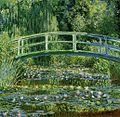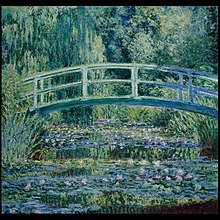Attēls:Water-Lilies-and-Japanese-Bridge-(1897-1899)-Monet.jpg

Šī priekšskata izmērs: 617 × 599 pikseļi. Citi izmēri: 247 × 240 pikseļi | 494 × 480 pikseļi | 791 × 768 pikseļi | 1 031 × 1 001 pikseļi.
Sākotnējais fails (1 031 × 1 001 pikseļi, faila izmērs: 381 KB, MIME tips: image/jpeg)
Faila hronoloģija
Uzklikšķini uz datums/laiks kolonnā esošās saites, lai apskatītos, kā šis fails izskatījās tad.
| Datums/Laiks | Attēls | Izmēri | Dalībnieks | Komentārs | |
|---|---|---|---|---|---|
| tagadējais | 2009. gada 19. janvāris, plkst. 23.57 |  | 1 031 × 1 001 (381 KB) | Krscal | {{Information |Description={{en|1=Water Lilies and Japanese Bridge (1897-1899) by Claude Monet Princeton University Art Museum}} |Source=the-athenaeum.org http://www.the-athenaeum.org/art/full.php?ID=3788 |Author=Claude Monet |Date=1897-1899 |Permission= |
Faila lietojums
Šo failu izmanto šajā 1 lapā:
Globālais faila lietojums
Šīs Vikipēdijas izmanto šo failu:
- Izmantojums ceb.wikipedia.org
- Izmantojums cs.wikipedia.org
- Izmantojums cy.wikipedia.org
- Izmantojums en.wikipedia.org
- Izmantojums en.wikivoyage.org
- Izmantojums et.wikipedia.org
- Izmantojums fr.wikivoyage.org
- Izmantojums ja.wikipedia.org
- Izmantojums kbp.wikipedia.org
- Izmantojums pl.wikipedia.org
- Izmantojums pt.wikipedia.org
- Izmantojums ro.wikipedia.org
- Izmantojums sl.wikipedia.org
- Izmantojums sq.wikipedia.org
- Izmantojums sv.wikipedia.org
- Izmantojums ta.wikipedia.org
- Izmantojums vi.wikipedia.org



